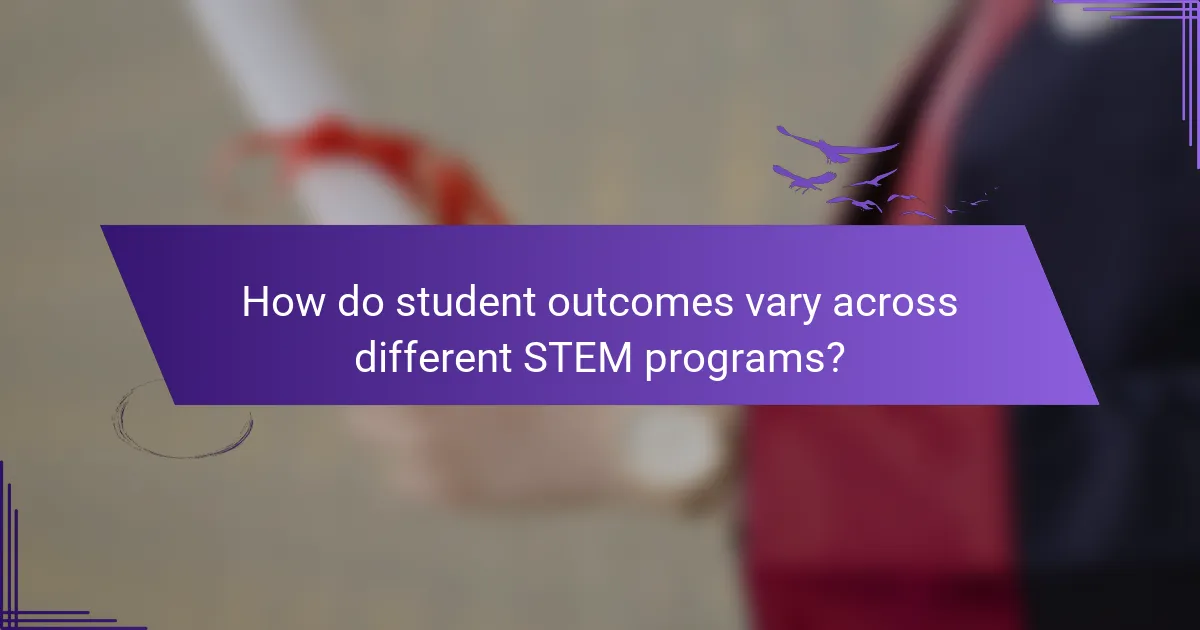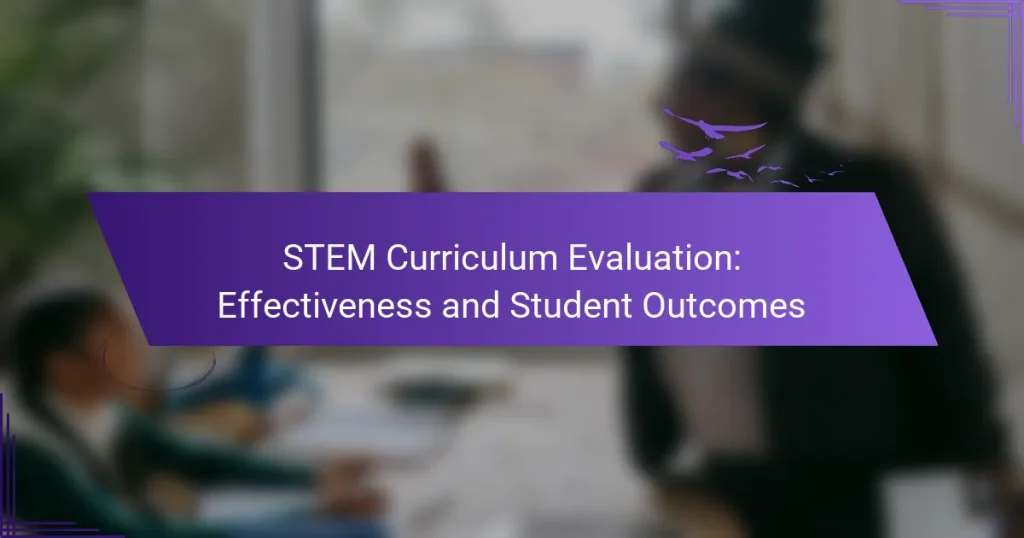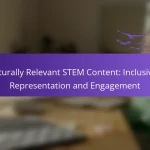The evaluation of STEM curricula in the United States plays a crucial role in improving educational outcomes by identifying strengths and weaknesses in teaching strategies. By focusing on the effectiveness of programs in science, technology, engineering, and mathematics, educators can align their methods with educational standards and enhance student performance through systematic assessment and stakeholder feedback.

How effective is STEM curriculum evaluation in the United States?
STEM curriculum evaluation in the United States is highly effective in enhancing educational outcomes. By systematically assessing the curriculum, educators can identify strengths and weaknesses, leading to improved teaching strategies and student performance.
Improved student engagement
Effective STEM curriculum evaluation significantly boosts student engagement. When curricula are assessed and adjusted based on student feedback and performance, lessons become more relevant and interesting, leading to higher participation rates.
For example, incorporating hands-on projects and real-world applications can make STEM subjects more appealing. Schools that adapt their programs based on evaluations often see a noticeable increase in student enthusiasm and involvement in STEM activities.
Enhanced critical thinking skills
STEM curriculum evaluation fosters enhanced critical thinking skills among students. By focusing on problem-solving and analytical tasks, evaluations help educators refine their teaching methods to encourage deeper cognitive engagement.
Programs that emphasize inquiry-based learning and collaborative projects can significantly improve students’ ability to think critically. Evaluating these programs allows for continuous improvement, ensuring that students develop essential skills for future challenges.
Increased standardized test scores
Regular evaluation of STEM curricula often leads to increased standardized test scores. By identifying effective teaching practices and content areas that need improvement, schools can better prepare students for assessments.
Research indicates that schools implementing data-driven evaluations see test score improvements in the range of 10-20%. This is particularly evident in subjects like mathematics and science, where targeted interventions can make a substantial difference in student performance.

What are the key components of STEM curriculum evaluation?
STEM curriculum evaluation focuses on assessing the effectiveness of educational programs in science, technology, engineering, and mathematics. Key components include alignment with educational standards, evaluation of teaching methods, and analysis of student performance metrics.
Curriculum alignment with standards
Curriculum alignment with standards ensures that educational programs meet established benchmarks for quality and relevance. This involves mapping curriculum content to national or state standards, such as the Next Generation Science Standards (NGSS) in the United States or the National Curriculum in the UK.
To evaluate alignment, educators can conduct regular reviews of course materials and learning objectives. This process helps identify gaps and ensures that students are being taught the necessary skills and knowledge to succeed in STEM fields.
Assessment of teaching methods
Assessing teaching methods is crucial for determining their effectiveness in delivering STEM content. This can include observing classroom practices, gathering feedback from students, and analyzing engagement levels during lessons.
Effective teaching strategies may involve hands-on activities, collaborative projects, and the integration of technology. Educators should regularly reflect on their methods and be open to adopting new approaches based on student needs and learning outcomes.
Student performance metrics
Student performance metrics provide quantitative data on how well learners are achieving educational goals in STEM subjects. Common metrics include standardized test scores, project assessments, and participation in STEM-related extracurricular activities.
To gain a comprehensive view of student performance, educators should consider multiple data points and trends over time. This can help identify areas for improvement and inform instructional adjustments to better support student learning.

What are the best practices for evaluating STEM curricula?
Effective evaluation of STEM curricula involves systematic approaches that enhance learning outcomes and student engagement. Best practices include utilizing formative assessments, incorporating stakeholder feedback, and conducting regular curriculum reviews.
Utilizing formative assessments
Formative assessments are tools used to monitor student learning and provide ongoing feedback. These assessments can take various forms, such as quizzes, group discussions, or project-based evaluations, allowing educators to adjust instruction based on student needs.
Implementing formative assessments regularly helps identify areas where students struggle, enabling timely interventions. For example, using quick exit tickets at the end of a lesson can reveal understanding gaps that need addressing in future classes.
Incorporating stakeholder feedback
Gathering feedback from stakeholders, including students, parents, and teachers, is crucial for evaluating STEM curricula. This input can provide diverse perspectives on curriculum effectiveness and areas for improvement.
Surveys or focus groups can be effective methods for collecting stakeholder opinions. For instance, asking parents about their children’s engagement with STEM subjects can highlight strengths and weaknesses in the curriculum that may not be evident from test scores alone.
Regular curriculum reviews
Conducting regular curriculum reviews ensures that the STEM curriculum remains relevant and effective. These reviews should assess alignment with educational standards, current scientific advancements, and student interests.
Establishing a review cycle, such as every three to five years, allows for systematic updates. During these reviews, educators should analyze student performance data and incorporate new teaching strategies or technologies to enhance learning experiences.

How can online courses enhance STEM curriculum evaluation?
Online courses can significantly improve STEM curriculum evaluation by providing flexible learning options, diverse resources, and robust data analytics. These features enable educators to assess student engagement and performance more effectively, leading to better educational outcomes.
Flexible learning environments
Online courses create flexible learning environments that cater to diverse student needs. Students can access materials at their own pace, allowing for personalized learning experiences that accommodate different learning styles and schedules.
This flexibility can lead to increased student motivation and engagement, as learners can choose when and how to study. For instance, a student struggling with a particular concept can revisit lectures or resources without the pressure of a traditional classroom setting.
Access to diverse resources
Online courses provide students with access to a wide range of resources that may not be available in a conventional classroom. This includes interactive simulations, video tutorials, and access to global experts through webinars.
Such resources can enhance understanding and application of STEM concepts. For example, a biology student might use online lab simulations to conduct experiments virtually, gaining hands-on experience without the constraints of physical lab space.
Data analytics for performance tracking
Data analytics in online courses allows educators to track student performance in real-time. This capability enables instructors to identify trends, such as which topics students struggle with the most, and adjust the curriculum accordingly.
Utilizing analytics tools can help in making informed decisions about instructional strategies. For example, if data shows that a significant number of students are failing quizzes on a specific topic, educators can provide additional resources or targeted interventions to address those gaps.

What frameworks support effective STEM curriculum evaluation?
Effective STEM curriculum evaluation is supported by various frameworks that guide educators in assessing the quality and impact of their programs. These frameworks help ensure that curricula are aligned with educational goals and standards, ultimately enhancing student outcomes.
Understanding by Design (UbD)
Understanding by Design (UbD) is a framework that emphasizes the importance of planning curriculum with the end goals in mind. It encourages educators to identify desired learning outcomes and then design assessments and instructional strategies that align with those outcomes.
In practice, UbD involves three stages: identifying desired results, determining acceptable evidence, and planning learning experiences. For example, a STEM curriculum might start with the goal of students mastering the scientific method, followed by assessments that measure their understanding through experiments and projects.
Backward Design model
The Backward Design model is similar to UbD, focusing on starting with the desired outcomes before planning the curriculum. This approach ensures that all instructional activities and assessments are directly linked to the learning objectives.
When using the Backward Design model, educators first define what students should know and be able to do by the end of a course. Next, they develop assessments to measure these outcomes, followed by designing lessons that prepare students for those assessments. This method can lead to more coherent and focused STEM instruction, as each component of the curriculum is purposefully aligned.

What are the challenges in STEM curriculum evaluation?
Evaluating STEM curricula presents several challenges that can hinder effective assessment and improvement. Key issues include resource limitations and resistance to change, both of which can impact the quality and implementation of evaluation processes.
Resource limitations
Resource limitations often restrict the ability to conduct thorough evaluations of STEM curricula. Schools may lack adequate funding, personnel, or technology to implement comprehensive assessment strategies. For instance, smaller institutions might struggle to allocate budget for data collection tools or professional development for staff.
Additionally, time constraints can affect the evaluation process. Educators may find it challenging to balance curriculum evaluation with their teaching responsibilities, leading to superficial assessments. Prioritizing evaluation activities and seeking external funding or partnerships can help mitigate these limitations.
Resistance to change
Resistance to change is a significant barrier in STEM curriculum evaluation, as educators and administrators may be hesitant to alter established practices. This reluctance can stem from a fear of the unknown or a belief that current methods are sufficient. Engaging stakeholders early in the evaluation process can help address concerns and foster a more open mindset towards change.
To overcome resistance, it is essential to communicate the benefits of evaluation clearly. Providing evidence of improved student outcomes from previous curriculum changes can motivate educators to embrace new approaches. Professional development workshops that focus on the advantages of data-driven decision-making can also facilitate a smoother transition to updated curricula.

How do student outcomes vary across different STEM programs?
Student outcomes in STEM programs can significantly differ based on program structure, teaching methods, and resources available. Factors such as curriculum design, hands-on experiences, and student support services play crucial roles in shaping these outcomes.
Program Structure and Curriculum Design
The structure of a STEM program, including its curriculum design, directly influences student engagement and learning outcomes. Programs that integrate project-based learning and real-world applications tend to foster higher levels of critical thinking and problem-solving skills among students.
For example, a program that emphasizes collaborative projects may see students developing teamwork and communication skills, while those focusing on theoretical knowledge might yield stronger analytical capabilities. It’s essential for educators to align curriculum with industry needs to enhance student employability.
Teaching Methods and Instructional Strategies
Effective teaching methods are vital for improving student outcomes in STEM education. Programs that utilize active learning strategies, such as flipped classrooms or inquiry-based learning, often result in better retention of knowledge and increased student motivation.
In contrast, traditional lecture-based approaches may not engage students as effectively, leading to lower performance. Educators should consider incorporating diverse instructional strategies to cater to different learning styles and enhance overall comprehension.
Resources and Support Services
The availability of resources and support services significantly impacts student success in STEM programs. Access to modern technology, laboratories, and mentoring can enhance the learning experience and outcomes for students.
Programs that offer tutoring, career counseling, and internship opportunities typically see higher graduation rates and job placements. Institutions should prioritize resource allocation to ensure that students have the necessary support to thrive in their STEM studies.


